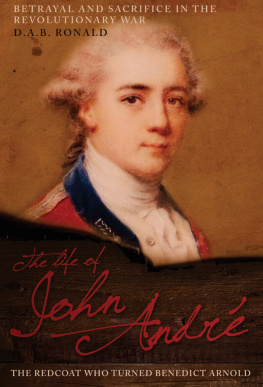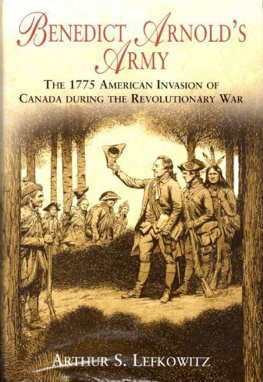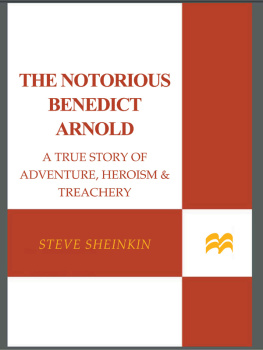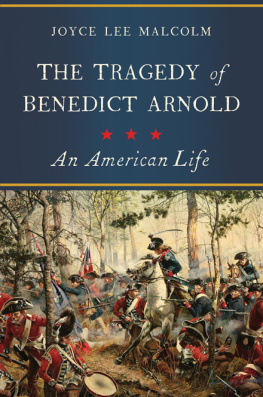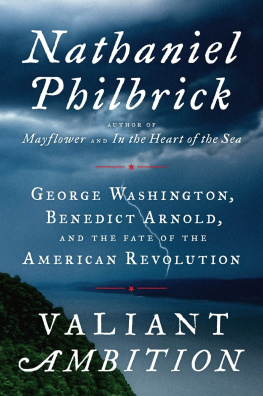Published with assistance from the Annie Burr Lewis Fund.
Copyright 2018 Stephen Brumwell
All rights reserved. This book may not be reproduced in whole or in part, in any form (beyond that copying permitted by Sections 107 and 108 of the U.S. Copyright Law and except by reviewers for the public press) without written permission from the publishers.
For information about this and other Yale University Press publications, please contact:
U.S. Office:
Europe Office:
Set in Minion Pro by IDSUK (DataConnection) Ltd
Printed in Great Britain by TJ International Ltd, Padstow, Cornwall
Library of Congress Control Number: 2018936161
ISBN 978-0-300-21099-6
A catalogue record for this book is available from the British Library.
10 9 8 7 6 5 4 3 2 1
1. Colonel Arnold, Who commanded the Provincial troops sent against Quebec, through the wilderness of Canada, and was wounded in storming that city, under General Montgomery. There is no suggestion that this mezzotint, published by Thomas Hart of London in March 1776, provides a genuine likeness of Arnold. Nonetheless, it demonstrates how his reputation as a determined fighter for American liberty was swiftly spread among Britons.
2. General Arnold, Drawn from the life at Philadelphia by Du Simitier [sic]. Taken by the Swiss artist and collector Pierre Eugne Du Simitire in 177879 during Arnolds residence in the city, this is the only authentic likeness of the celebrated soldier before his defection to the British. Published in London in March 1783, this engraved version reflects the continuing interest in Arnold even as the Revolutionary War ended.
3. The Death of General Montgomery at Quebec, an engraving made in 1808 by Christian Wilhelm Ketterlinus from the 1786 painting by John Trumbull. This was one of a series of iconic images by which Trumbull commemorated pivotal moments in the Revolutionary War, dramatizing the sacrifices and victories of the Patriots. Had he not turned traitor, its likely that Arnolds exploits would have featured among them.
4. The attack and defeat of the American fleet under Benedict Arnold upon Lake Champlain, the 11th of October 1776. Based on a participants sketch, this engraved map of the battle of Valcour Island was published in London by William Faden within two months, on December 3, 1776. This detail shows how Arnold exploited the congested location to restrict the superior British fleet.
5. A Skirmish in America between the Kings Troops and General Arnold. Published by James Sharpe of London in April 1780, this rare print commemorates Arnolds intrepidity at Ridgefield, Connecticut, some three years earlier. While Danbury blazes in the distance, Arnold prepares to pistol a bayonet-wielding British grenadier. A unique image, dating from before the revelation of Arnolds treason, it draws upon published accounts. The print is on display at the Keeler Tavern Museum in Ridgefield, a building dating from 1713 in which a British cannonball fired during the fighting of 1777 remains embedded.

6. Margaret Peggy Shippen depicted in a watercolor by John Andr, worked up from a pencil sketch he made before June 1778. The teenaged Peggy is dressed for a formal ball and sports the exaggerated style of headdress that outraged Philadelphias radical Patriots once the British army had evacuated the city. Soon after, she attracted the attentions of her future husband, Major-General Benedict Arnold.
7. West Point in August 1782, shown in a detail from a panorama of the Encampment of the Revolutionary Army on the Hudson River, by Major Pierre Charles LEnfant. A French volunteer and engineer in the Continental Army, LEnfant was wounded during the siege of Savannah in 1779 and captured at Charleston in 1780. Although West Points fortifications are indistinct, his watercolor gives a strong sense of their dramatic setting.
8. General Washington, a mezzotint by Valentine Green, published in London in 1799, and based on John Trumbulls painting of 1780. Trumbull, who had served as an aide to Washington early in the Revolutionary War, portrayed him at the time of Arnolds treason as a lean and active forty-eight-year-old. Shadowed by his slave Billy Lee, Washington is posed against a rugged landscape resembling the Hudson Highlands.
9. A self-portrait by Major John Andr, made on the morning of October 1, 1780, when he was confined at the Mabie Tavern, Tappan, and expected to be executed within hours. Andr worked without a mirror and presented the pen and ink drawing as a keepsake to one of his guards, Ensign Jabez Tomlinson of Samuel Webbs Additional Continental Regiment. He was hanged at noon the next day, October 2.
10. Major John Andr, Adjutant-General to His Majestys forces in North America under the command of Sir Henry Clinton. Andr was a prolific artist, and this engraving by John Keyse is based upon an earlier self-portrait. Published in London in 1784, it testifies to the enduring public interest in his fate; this was heightened in 1782 when a monument to his memory was erected in Westminster Abbey.
11. A Representation of the Figures Exhibited and Paraded through the streets of Philadelphia. Issued as a broadsheet, this crude print gives a vivid impression of the procession staged on September 30, 1780 to vilify Arnold for his treachery. It illustrates the realistic effigies of Arnold and Beelzebub that were specially created for the event by local artist Charles Willson Peale. In the background, Arnold escapes to HMS


